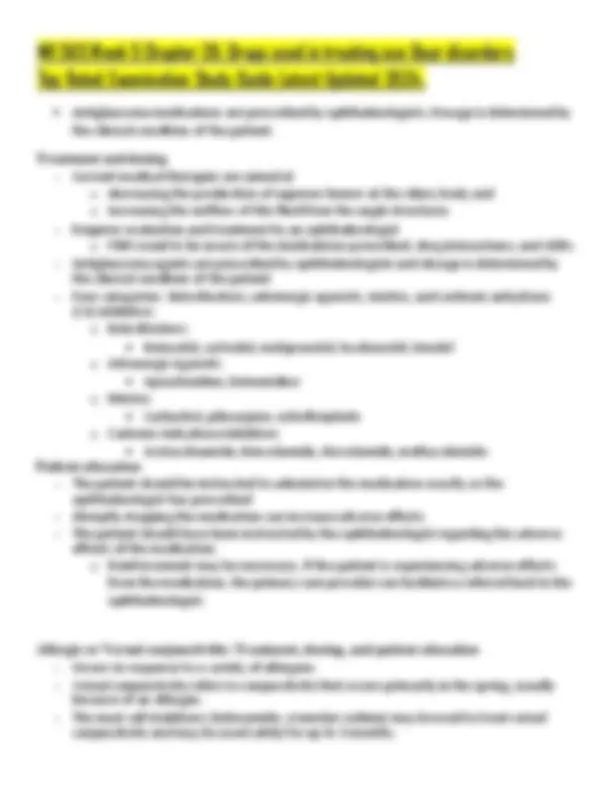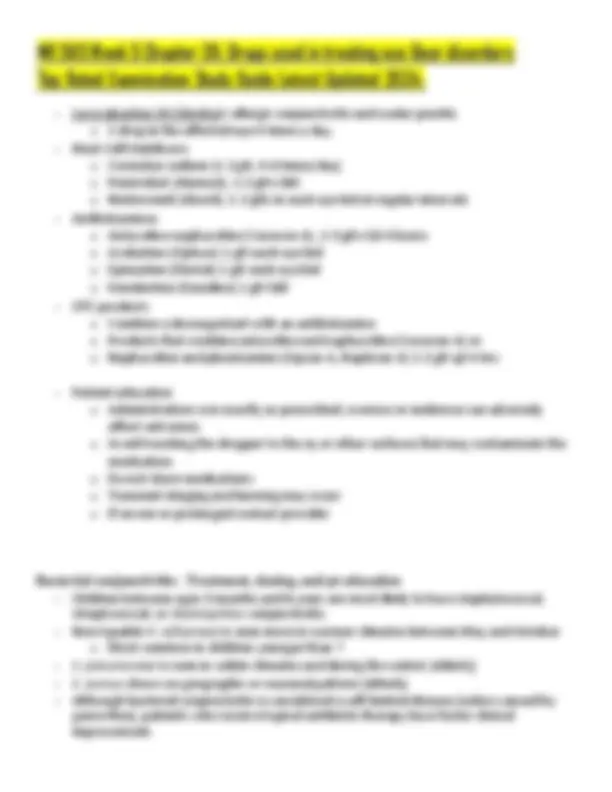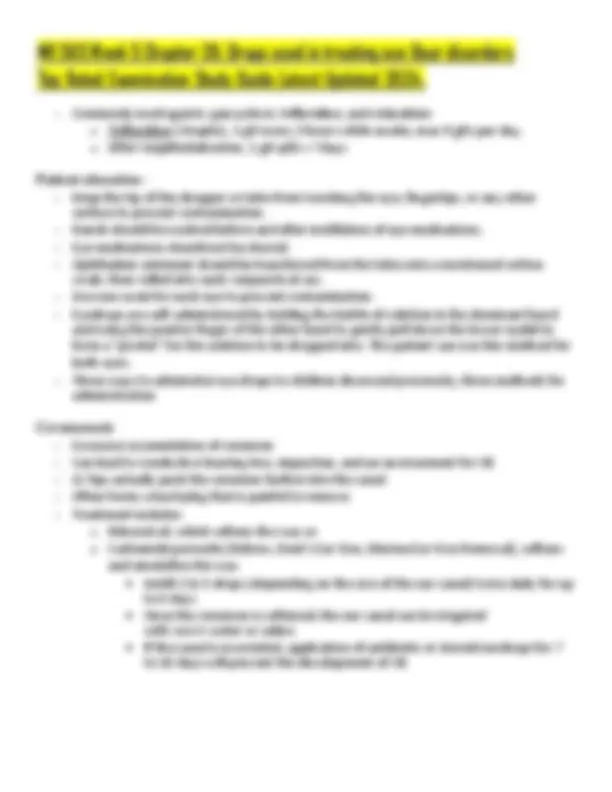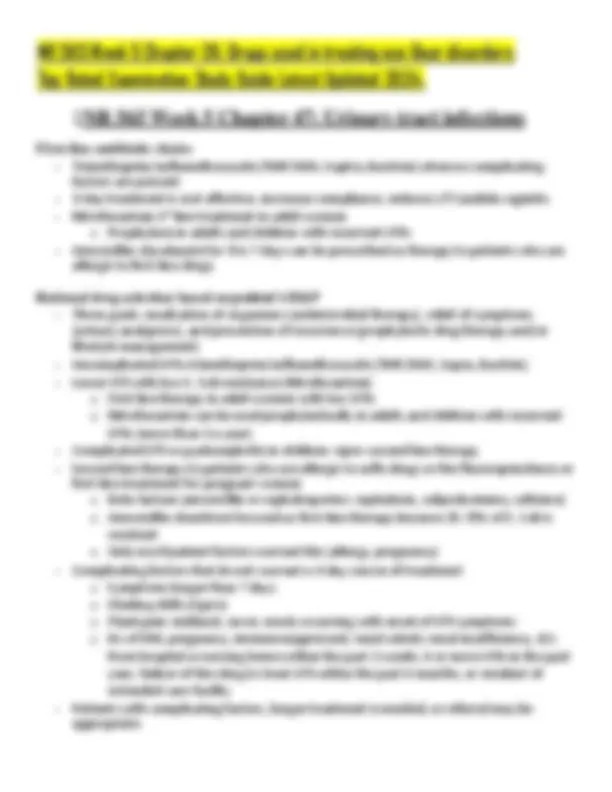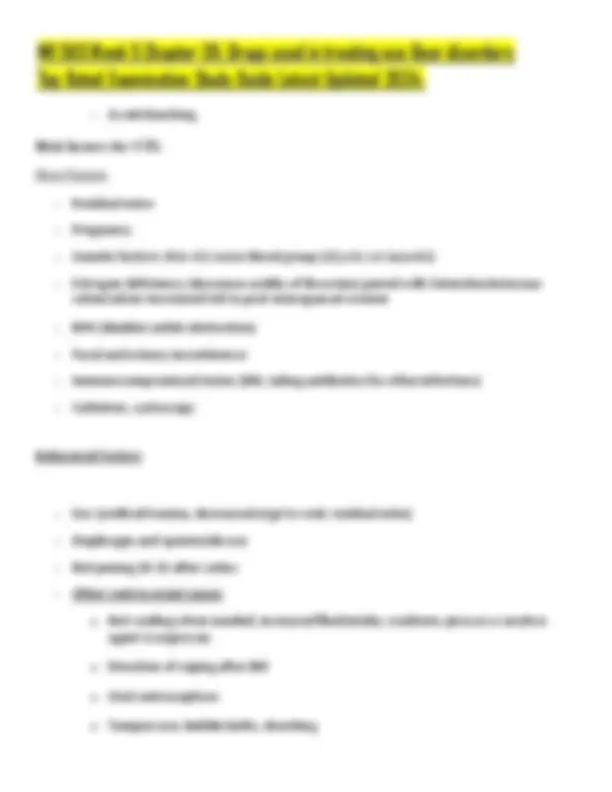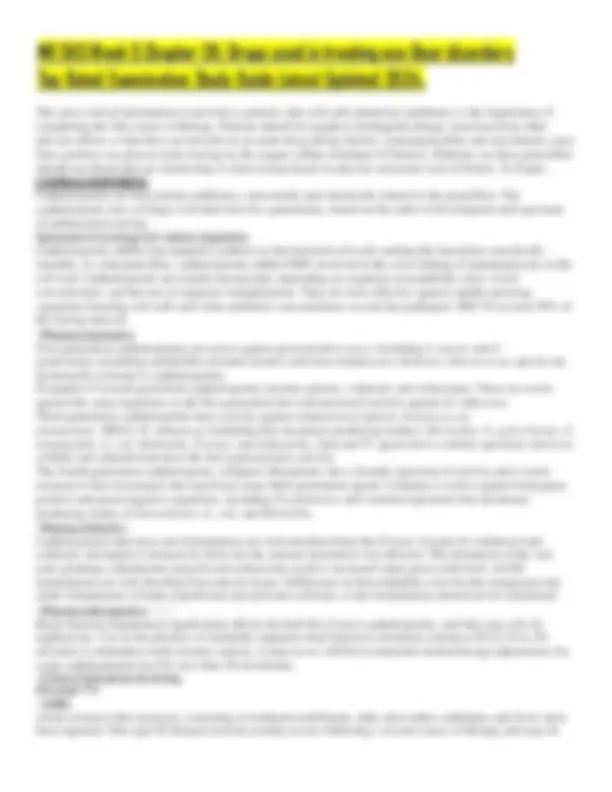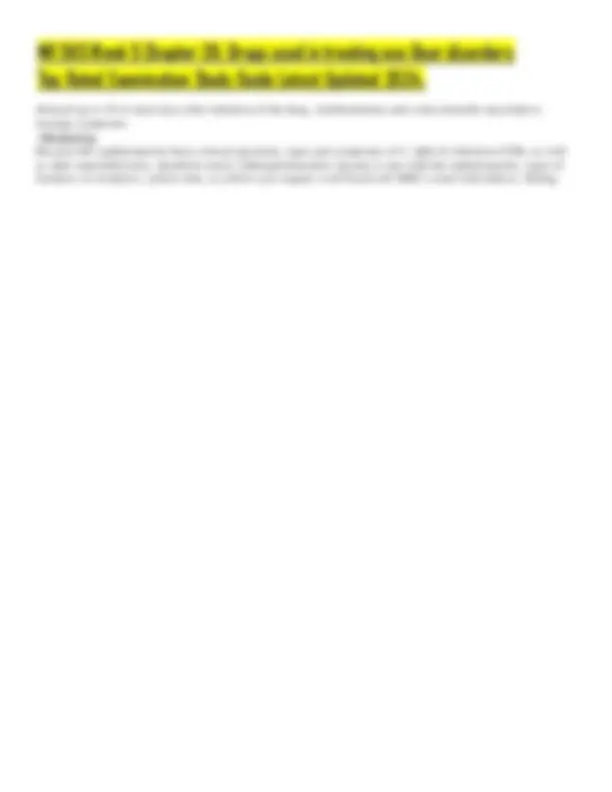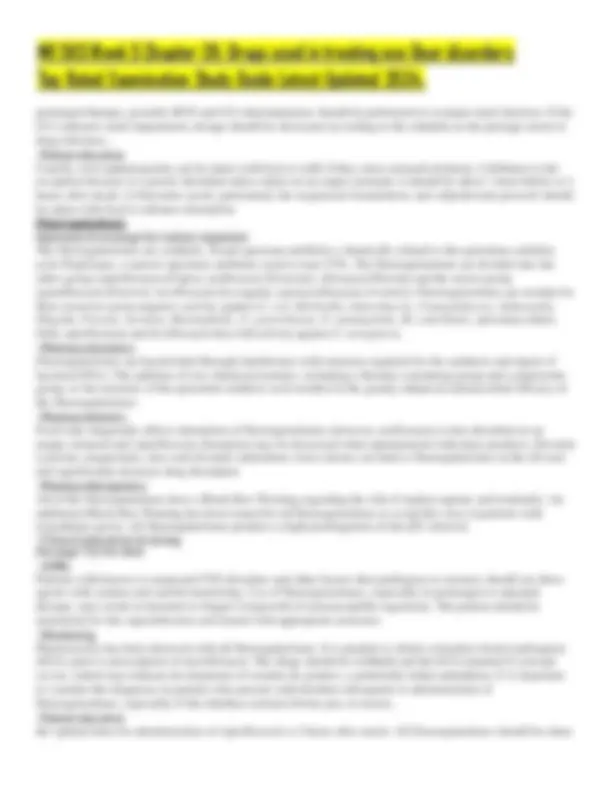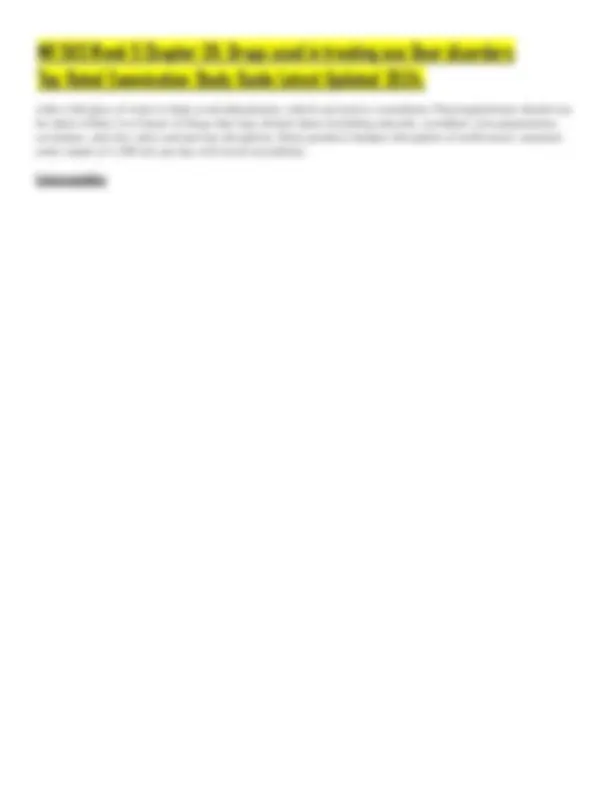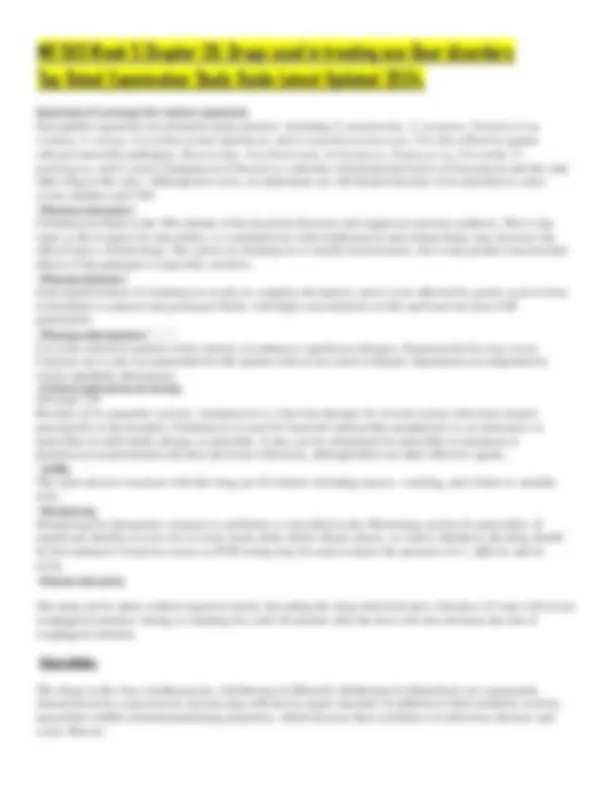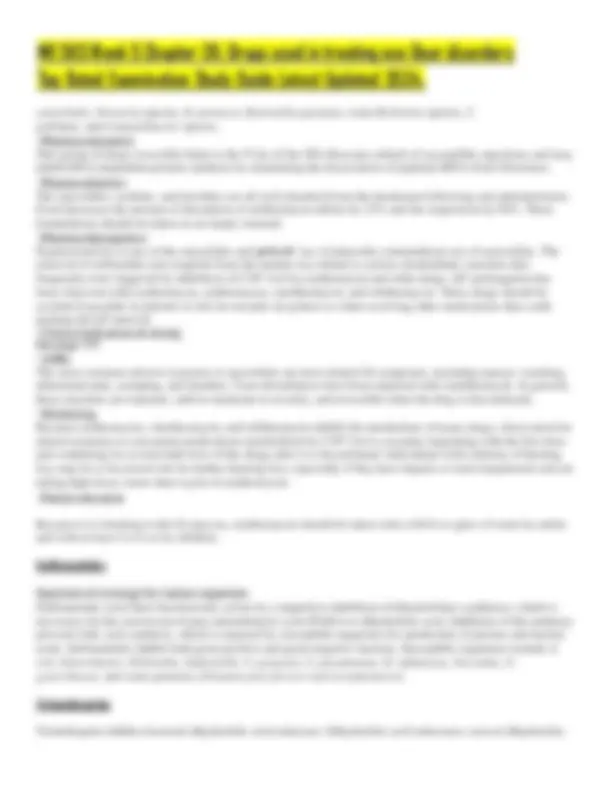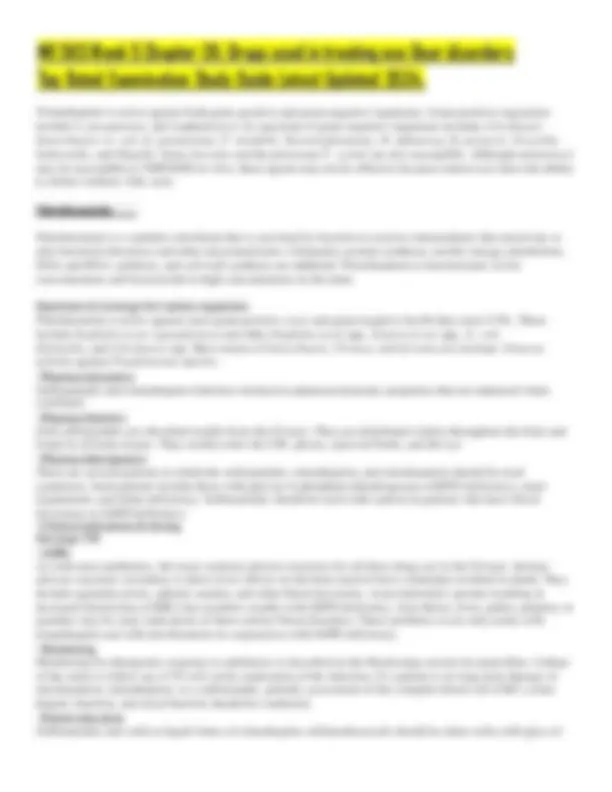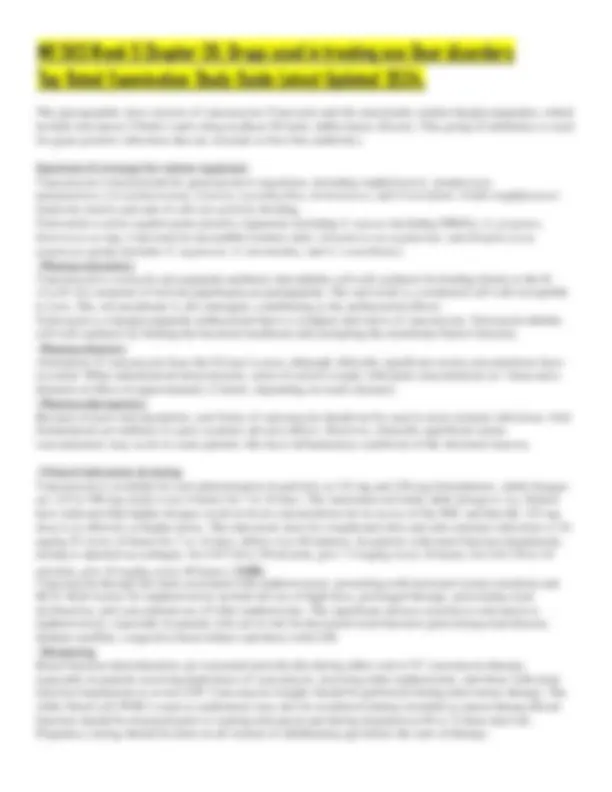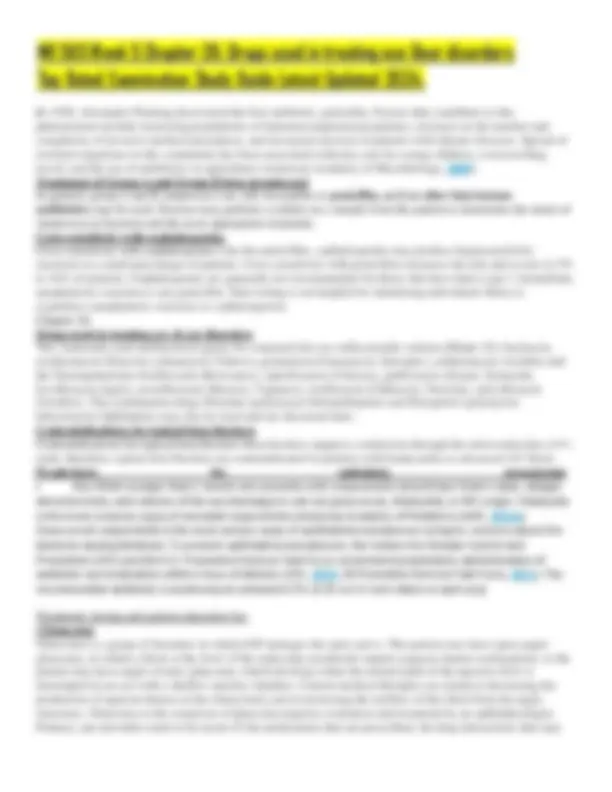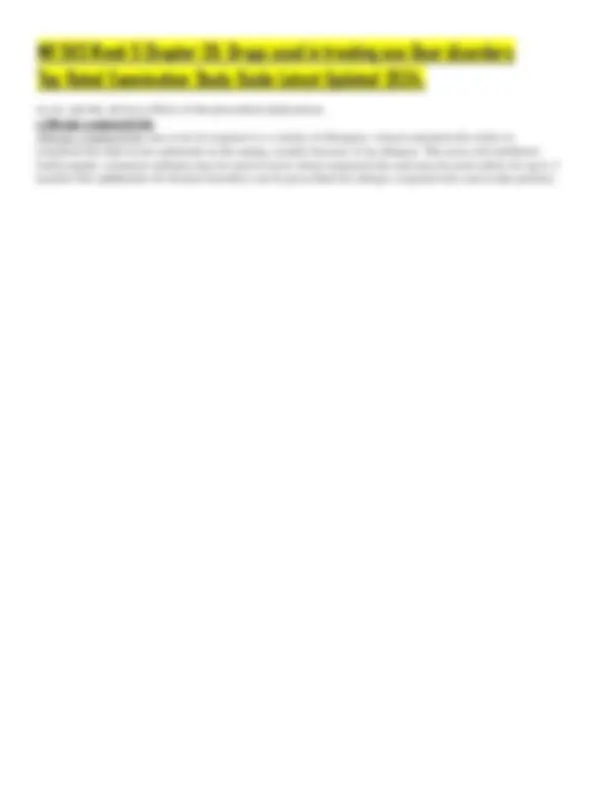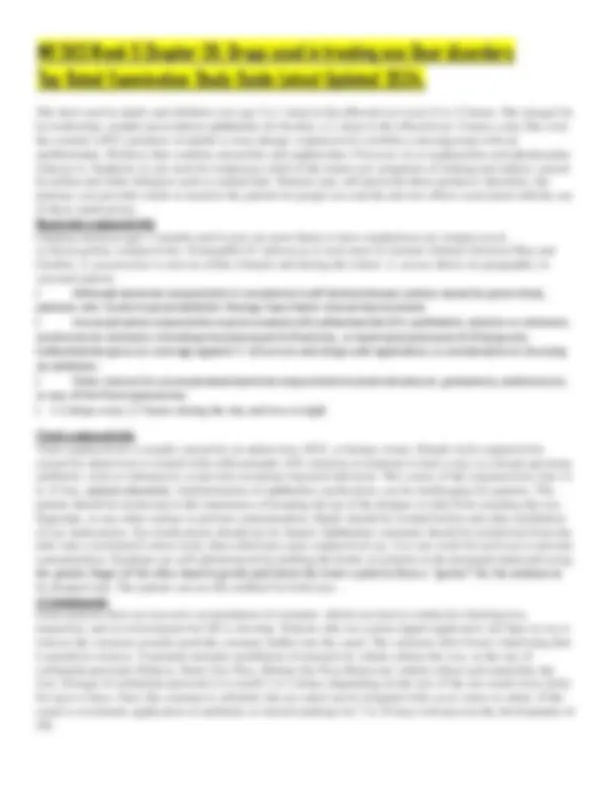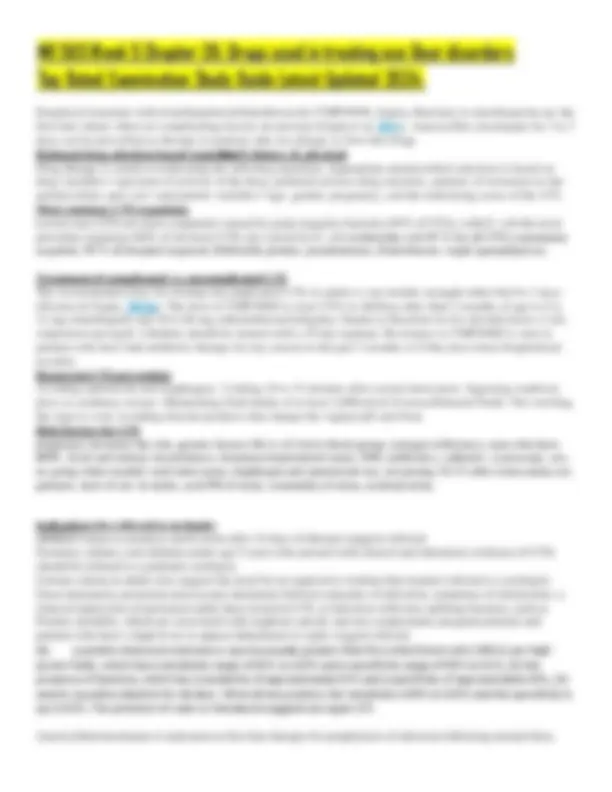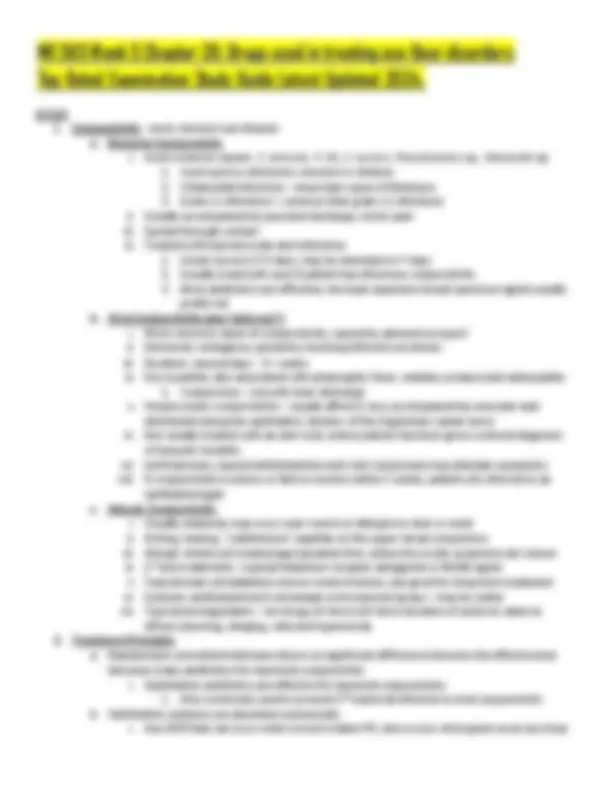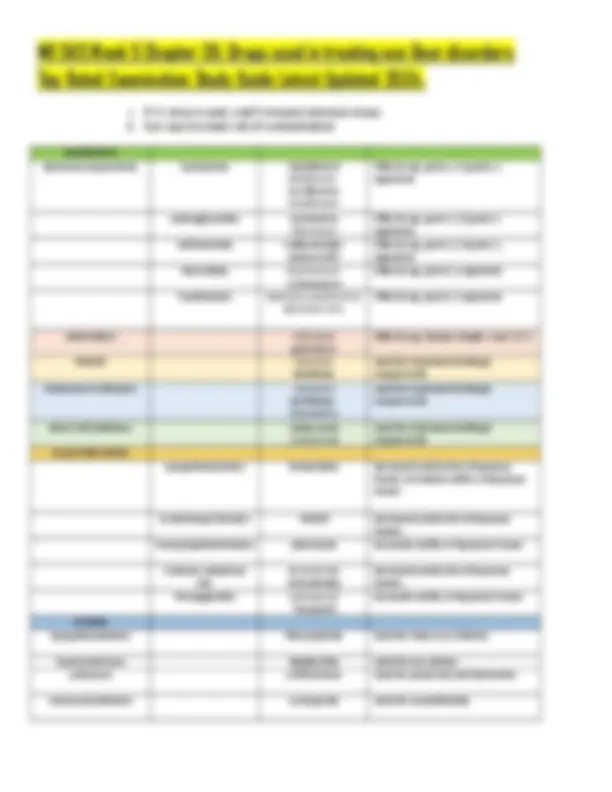Download Top Rated Study Guide: Drugs for Eye & Ear Disorders - NR 565 Week 5 Ch. 26 and more Exams Nursing in PDF only on Docsity!
Top Rated Examination Study Guide Latest Updated 2024.
NR 565 Week 5 Chapter 26: Drugs used in treating eye &
ear disorders
Contraindications for topical beta blockers Beta blockers
- Suppress conduction through the atrioventricular (AV) node; therefore, topical beta blockers are contraindicated in patients with bradycardia or advanced AV block.
- Do not use in patients with compromised ventricular dysfunction, cardiogenic shock, or with systolic congestive HF
- D/c at first sign of cardiac failure
- Contraindicated with hypotension
- Use with caution: poorly controlled DM and hyperthyroidism
- Surgical patients should be monitored closely for cardiac failure o Withdraw before surgery 2 days prior
- Contraindicated with Raynaud’s disease or PVD, CVD
- Preg cat C: fetal anomalies and fetotoxicity in animal studies
2 Prophylaxis for opthalmia neonatorum
- Common patient group: infants younger than 1 month who presents with conjunctivitis should have Gram's stain, antigen detection tests, and cultures of the eye discharge to rule out gonococcal, chlamydial, or HSV origin. - Chlamydia is the most common cause of neonatal conjunctivitis - Gonococcal conjunctivitis is the most serious cause of ophthalmia neonatorum owing to concerns about the bacteria causing blindness - Prophylaxis: Administration of antibiotic eye medication within 1 hour of delivery - Erythromycin ointment 0.5% (0.25 to 0.5-inch ribbon in each eye) - Chlamydial conjunctivitis is not prevented by prophylactic use of erythromycin at birth therefore any mucopurulent eye discharge in the first few weeks of life should be evaluated for chlamydia.
Glaucoma : Treatment, dosing, and patient education:
- IOP damages the optic nerve
Top Rated Examination Study Guide Latest Updated 2024.
- Leading cause of blindness worldwide - 6-8 times more likely in African Americans than Caucations
Top Rated Examination Study Guide Latest Updated 2024.
Treatment and Dosing
- Ketotifen (H1 blocker) for allergic conjunctivitis and ocular pruritus. o The dose used in adults and children over age 3 is 1 drop in the affected eye every 8 to 12 hours
Top Rated Examination Study Guide Latest Updated 2024.
- Levocabastine (H1 blocker): allergic conjunctivitis and ocular pruritis o 1 drop in the affected eye 4 times a day.
- Mast Cell Stabilizers: o Cromolyn sodium (1-2 gtt, 4-6 times/day) o Pemirolast (Alamast), 1-2 gtts QID o Nedocromil (Alocril), 1-2 gtts in each eye bid at regular intervals
- Antihistamines o Antazoline-naphazoline (Vasocon-A), 1-3 gtts Q3-4 hours o Azelastine (Optivar) 1 gtt each eye bid o Epinastine (Elestat) 1 gtt each eye bid o Emedastine (Emadine) 1 gtt QID
- OTC products o Combine a decongestant with an antihistamine o Products that combine antazoline and naphazoline (Vasocon-A) or o Naphazoline and pheniramine (Opcon-A, Naphcon-A) 1-2 gtt q3-4 hrs
- Patient education o Administration: use exactly as prescribed, overuse or underuse can adversely affect outcomes o Avoid touching the dropper to the ey or other surfaces that may contaminate the medication o Do not share medications o Transient stinging and burning may occur o If severe or prolonged contact provider
Bacterial conjunctivitis: Treatment, dosing, and pt education
- Children between ages 3 months and 8 years are most likely to have staphylococcal, streptococcal, or Haemophilus conjunctivitis.
- Non-typable H. influenzae is seen more in warmer climates between May and October o Most common in children younger than 7
- S. pneumoniae is seen in colder climates and during the winter (elderly)
- S. aureus shows no geographic or seasonal pattern (elderly)
- Although bacterial conjunctivitis is considered a self-limited disease (unless caused by gonorrhea), patients who receive topical antibiotic therapy have faster clinical improvement.
Top Rated Examination Study Guide Latest Updated 2024.
▪ Or Ointment small amount tid-qid and qhs ▪ Not recommended for infants <2 months ▪ Sulfacetamide gives no coverage against H. influenzae and stings with application, a consideration in choosing an antibiotic o Erythromycin ointment ▪ 0.25-0.5 inch ribbon 2-3 times/day ▪ Safe in infants o Trimethoprim/polymyxin B (Polytrim) ▪ 1 gtt q3h for 7-10 days, up to 6 doses/day ▪ Not recommended for infants <2 months old o bacitracin/polymyxin B (Polysporin) ▪ 0.5 inch ribbon q 3-4 hours ▪ May be used safely in children o Other treatment options: tobramycin, gentamicin, azithromycin, or any fluoroquinolones o If caused by dacryostenosis (s. pneumonia or H. influenzae: treated with: erythromycin, tobramycin, or fluoroquinolones
- Patient Education o Administration: Keep tip of dropper or tube from touching the eye, fingertips, or any other surface o Moist cotton swab for application, one swab per eye o Hold bottle of solution with dominant hand using the pointer finger of the other hand to gently pull down on the lower lid to form a pocket for the solution to be dropped into o Methods for children (3) ▪ School aged children can assist by pulling down their own eyelid, care provider instills drops ▪ Lay down on back and close eyes, keeping the head still, a drop of the medication is placed on the inner canthus after placed child slowly opens the eye without moving the head. Medication instills ▪ Immobilize the patient one person holding and one person instilling o Transient burning or stinging, if sever or prolonged, contact provider
Viral Conjunctivitis: Treatment, dosing, and patient education
- Viral conjunctivitis is usually caused by an adenovirus, HSV, or herpes zoster.
- Simple viral conjunctivitis caused by adenovirus is treated with sulfacetamide 10% solution or ointment 4 times a day or a broad-spectrum antibiotic, such as tobramycin,
Top Rated Examination Study Guide Latest Updated 2024.
to prevent secondary bacterial infection.
- The course of the conjunctivitis runs 12 to 15 day
- Herpes keratitis is a potentially serious consequence of HSV infection o If suspected referral to an ophthalmologist for Dx and Tx is indicated
Top Rated Examination Study Guide Latest Updated 2024.
Q NR 565 Week 5 Chapter 47: Urinary tract infections
First-line antibiotic choice
- Trimethoprim/sulfamethoxazole (TMP/SMX, Septra, Bactrim) when no complicating factors are present
- 3-day treatment is cost effective, increases compliance, reduces r/f Candida vaginitis
- Nitrofurantoin 1st^ line treatment in adult women o Prophylaxis in adults and children with recurrent UTIs
- Amoxicillin-clavulanate for 3 to 7 days can be prescribed as therapy to patients who are allergic to first-line drugs
Rational drug selection based on patient’s H&P
- Three goals: eradication of organisms (antimicrobial therapy), relief of symptoms (urinary analgesics), and prevention of recurrence (prophylactic drug therapy and/or lifestyle management)
- Uncomplicated UTIs-trimethoprim/sulfamethoxazole (TMP/SMX, Sepra, Bactrim)
- Lower UTI with low E. Coli resistance (Nitrofurantoin) o First line therapy in adult women with low UTIs o Nitrofurantoin can be used prophylactically in adults and children with recurrent UTIs (more than 3 a year)
- Complicated UTI or pyelonephritis in children: cipro-second line therapy
- Second line therapy to patients who are allergic to sulfa drugs or the fluoroquinolones or first-line treatment for pregnant women o Beta-lactam (amoxicillin or cephalosporins: cephalexin, cefpodoximine, cefixime) o Amoxicillin should not be used as first-line therapy because 25-70% of E. Coli is resistant o Only use if patient factors warrant this (allergy, pregnancy)
- Complicating factors that do not warrant a 3-day course of treatment o Symptoms longer than 7 days o Shaking chills (rigors) o Flank pain: midback, sever, newly occurring with onset of UTI symptoms o Hx of DM, pregnancy, immunosuppressed, renal calculi, renal insufficiency, d/c from hospital or nursing home within the past 2 weeks, 4 or more UTIs in the past year, failure of this drug to treat UTI within the past 4 months, or resident of extended care facility
- Patients with complicating factors, longer treatment is needed, or referral may be appropriate
Top Rated Examination Study Guide Latest Updated 2024.
- Use urine C&S to guide therapy
- Adult Prophylaxis: drug of choice for adult prophylaxis is one single-strength tablet of trimethoprim/sulfamethoxazole daily at bedtime for a minimum of 6 months or self- administrated single dose of two double strength tablets at symptoms onset
Top Rated Examination Study Guide Latest Updated 2024.
- Void 10-15 minutes after intercourse
- Ingesting cranberry juice
- Maintaining fluid intake of 2000 mL/day
- Not resisting the urge to voice or “holding it”
Top Rated Examination Study Guide Latest Updated 2024.
Risk factors for UTI:
Host Factors
- Residual urine
- Pregnancy
- Genetic factors: HLA-A3, Lewis blood group (LE(a-b-) or Le(a+b1)
- Estrogen deficiency (decreases acidity of the urine) paired with Enterobacteriaceae colonization=increased risk in post-menopausal women
- BPH (bladder outlet obstruction)
- Fecal and urinary incontinence
- Immunocompromised states (DM, taking antibiotics for other infections)
- Catheters, cystoscopy
Behavioral Factors
- Sex (urethral trauma, decreased urge to void, residual urine)
- Diaphragm and spermicide use
- Not peeing 10-15 after coitus
- Other controversial causes
o Not voiding when needed, increased fluid intake, cranberry juice as a curative agent is unproven
o Direction of wiping after BM
o Oral contraceptives
o Tampon use, bubble baths, douching
Top Rated Examination Study Guide Latest Updated 2024.
- Other factors: virulence of the organism, ability of the organism to survive the urinary tract environment o Some bacteria are more tolerant to low pH
- Inflammatory reaction to bacteria o Prostaglandins from mast cell produce pain, increase vascular permeability ie. Hematuria
Indications for referral to urologist :
- Children with vesicoureteral reflux, +VUR, renal scarring, or structural abnormalities should be referred to a pediatric urologist
- Neonates, infants, and children under age 5 years who present with clinical and laboratory evidence of UTIs should be referred to a pediatric urologist.
- Children with an identified renal or bladder stone should be referred to a pediatric urologist
- Children: if no sterile urine after 14 days and re-culture 24-48 hours after completion of therapy of therapy suggests referral.
- Adolescents with pyelonephritis or a second UTI with documented positive urine cultures and no Hx of sexual activity should receive a consultation
- Adult women: Refer if symptoms persist beyond two weeks despite treatment
- Men: dysuria, frequency, urgency with negative UA and culture
- Men who do not respond to two different antimicrobials
- Adults: Gross hematuria; persistent microscopic hematuria between episodes of infection; symptoms of obstruction; a clinical impression of persistent rather than recurrent UTI, or infection with urea-splitting bacteria, such as Proteus mirabilis, which are associated with staghorn calculi; and any symptomatic pregnant patients and patients who have a high fever or appear dehydrated or septic suggest referral.
Top Rated Examination Study Guide Latest Updated 2024.
PENICILLINS
Spectrum of coverage for various organisms Penicillins are characterized chemically by the 6-aminopenicillanic acid joined to the beta-lactam ring. Attachment of different substitutes to 6-aminopenicillanic acid results in different pharmacological and antibacterial characteristics, which are the basis for four penicillin subclasses: (1) penicillinase-sensitive or natural penicillins, (2) aminopenicillins, (3) penicillinase-resistant or antistaphylococcal penicillins, and (4) anti-pseudomonal or extended-spectrum penicillins.
- Pharmacodynamics Penicillins hinder bacterial growth by inhibiting the biosynthesis of bacterial cell wall mucopeptide (also called murein or peptidoglycan). This action is dependent on the drug reaching the penicillin-binding proteins (PBPs), which include transpeptidase, carboxypeptidase, and endopeptidase enzymes involved in the terminal stages of forming the cell wall. When penicillins bind to the PBPs, the wall is weakened and lysis of the bacterial cell wall occurs.
- Pharmacokinetics The extent of oral absorption of penicillins is dependent on the specific penicillin agent, the pH of the stomach and intestine, and presence of food. Although oral penicillin formulations are generally well absorbed from the GI tract, use is limited to mild to moderate infections because higher-than-recommended doses cause GI distress and diarrhea. In addition, serum concentrations do not rise proportionately with increased doses.
- Pharmacotherapeutics Although less than 10% of patients taking these drugs have an allergic reaction, penicillins are the most likely antibiotics to cause an allergic reaction. A history of a serious hypersensitivity reaction (e.g., anaphylaxis, serum sickness, exfoliative dermatitis, hemolysis, or other blood dyscrasia) to a penicillin contraindicates the use of any penicillin on account of crossreactivity. Severe, type I allergic reactions to cephalosporins, carbapenems, or beta-lactamase inhibitors may contraindicate use of penicillins.
- Clinical indications & dosing see page 705
- ADRs Serious and occasionally fatal immediate hypersensitivity reactions These reactions usually occur within 2 to 30 minutes after administration and are characterized by nausea, vomiting, urticaria, pruritus, tachycardia, severe dyspnea, diaphoresis, stridor, vertigo, and eventually loss of consciousness and circulatory collapse. Treatment is the same as for any anaphylactic reaction. Skin testing may be used to identify those at risk for penicillin allergy. A radioallergosorbent test (RAST), or a combination of RAST and minor determinant skin testing, may also be used. Patients should be referred to an allergist for skin testing. Patients with a known allergy or a positive skin test can be given desensitization therapy
- Monitoring Both microbiological and clinical responses are used to evaluate the therapeutic outcome of antimicrobial therapy. Serial cultures of specimens from infected sites become sterile with successful treatment. Follow-up cultures may detect superinfection or development of resistance. All patients with early or congenital syphilis should have a quantitative Venereal Disease Research Laboratory (VDRL) test at 6 and 12 months after therapy. For most infections treated in outpatient settings, it is sufficient to monitor clinical response alone. Local signs of heat, redness, swelling, tenderness, or discharge usually abate after 48 to 72 hours. Specific indicators of improvement such as the resolution of pulmonary infiltrates and normalization of pulse oximetry in pneumonia are important outcomes to monitor. Systemic signs such as fever, malaise, and leukocytosis also improve. The
Top Rated Examination Study Guide Latest Updated 2024.
The most critical information to provide to patients who will self-administer antibiotics is the importance of completing the full course of therapy. Patients should be taught to distinguish allergic reactions from other adverse effects so that they can provide an accurate drug allergy history. Aminopenicillins and clavulanate cause false positives on glucose urine testing by the copper sulfate technique (Clinitest). Diabetics on these penicillins should use blood glucose monitoring or urine testing based on glucose enzymatic tests (Clinstix, TesTape). CEPHALOSPORINS Cephalosporins are beta-lactam antibiotics, structurally and chemically related to the penicillins. The cephalosporin class of drugs is divided into five generations, based on the order of development and spectrum of antibacterial activity. Spectrum of coverage for various organisms Cephalosporins inhibit mucopeptide synthesis in the bacterial cell wall, making the bacterium osmotically unstable. As with penicillins, cephalosporins inhibit PBPs involved in the cross-linking of peptidoglycans in the cell wall. Cephalosporins are usually bactericidal, depending on organism susceptibility, dose, tissue concentration, and the rate of organism multiplication. They are most effective against rapidly growing organisms forming cell walls and when antibiotic concentrations exceed the pathogen's MIC for at least 50% of the dosing interval.
- Pharmacodynamics First-generation cephalosporins are active against gram-positive cocci, including S. aureus and S. epidermidis (excluding methicillin-resistant strains), and most streptococci; however, Enterococcus species are intrinsically resistant to cephalosporins. Examples of second-generation cephalosporins include cefaclor, cefprozil, and cefuroxime. These are active against the same organisms as the first generation but with increased activity against H. influenzae. Third-generation cephalosporins have activity against streptococcal species, Streptococcus pneumoniae, MSSA, H. influenzae (including beta-lactamase producing strains), Moraxella, N. gonorrhoeae, N. meningitidis, E. coli, Klebsiella, Proteus, and Salmonella. Oral and IV agents have a similar spectrum; however, cefdinir and cefpodoxime have the best gram-positive activity. The fourth-generation cephalosporin, cefepime (Maxipime), has a broader spectrum of activity and is more resistant to beta-lactamases that inactivate many third-generation agents. Cefepime is active against both gram- positive and gram-negative organisms, including Pseudomonas and extended-spectrum beta-lactamase producing strains of Enterobacter, E. coli, and Klebsiella.
- Pharmacokinetics Cephalosporins that have oral formulations are well absorbed from the GI tract. Except for cefadroxil and cefprozil, absorption is delayed by food, but the amount absorbed is not affected. The absorption of the oral ester prodrugs cefpodoxime proxetil and cefuroxime axetil is increased when given with food. All IM formulations are well absorbed from muscle tissue. Differences in bioavailability exist for the suspension and tablet formulations of both cefpodoxime proxetil and cefixime, so the formulations should not be substituted.
- Pharmacotherapeutics Renal function impairment significantly affects the half-life of most cephalosporins, and they may also be nephrotoxic. Use in the presence of markedly impaired renal function (creatinine clearance [CCr] 10 to 50 mL/min) is undertaken with extreme caution. Comparisons (2010) recommends titrated dosage adjustments for some cephalosporins for CCr less than 30 mL/minute.
- Clinical indications & dosing See page 711
- ADRs serum sickness–like reactions, consisting of erythema multiforme, other skin rashes, arthralgia, and fever, have been reported. This type III delayed reaction usually occurs following a second course of therapy and may be
Top Rated Examination Study Guide Latest Updated 2024.
delayed up to 10 or more days after initiation of the drug. Antihistamines and corticosteroids may help to manage symptoms.
- Monitoring Because the cephalosporins have a broad spectrum, signs and symptoms of C. difficile infection (CDI), as well as other superinfections, should be noted. Although hemolytic anemia is rare with the cephalosporins, signs of tiredness or weakness, yellow skin, or yellow eyes require a red blood cell (RBC) count with indices. During

